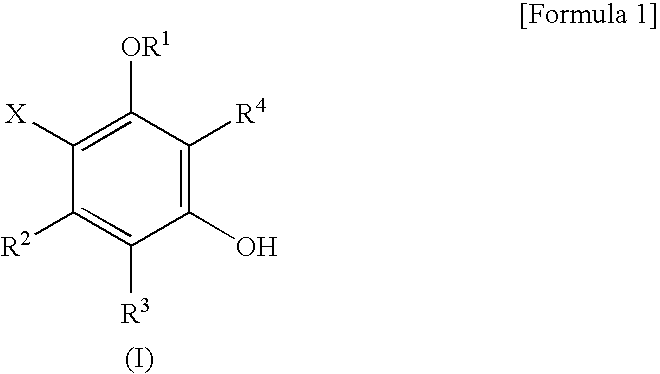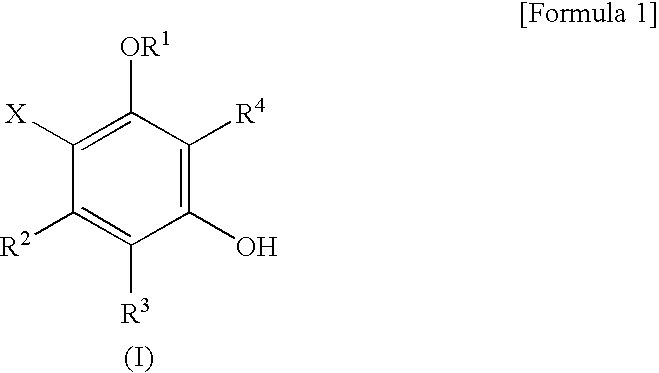Phenol derivatives and antitrypanosoma preventive/therapeutic agent comprising the same as active ingredient
a technology of phenol derivatives and active ingredients, applied in the direction of antiparasitic agents, biocides, drug compositions, etc., can solve the problems of inability to breed cattle, inability to confirm the number of patients of african sleeping sickness, damage to domestic animals,
- Summary
- Abstract
- Description
- Claims
- Application Information
AI Technical Summary
Benefits of technology
Problems solved by technology
Method used
Image
Examples
example 1
2,4-Dihydroxy-3-(1-hydroxydodecyl)-6-methylbenzaldehyde (Compound No.: 195-12)
[0072]2,4-Dihydroxy-6-methylbenzaldehyde (91 mg, 0.60 mmol) described in M. M. Joullie et al., J. Org. Chem., 50, 3997 (1985), dodecanal (133 mg, 0.72 mmol) and calcium chloride dihydrate (59 mg, 0.40 mmol) were stirred in a 0.4 M potassium hydroxide methanol solution (2 ml) at 0° C. for 24 hours. The reaction mixture was made acidic with 1 M hydrochloric acid. After extractive workup with ethyl acetate, the crude product was purified by silica gel thin-layer chromatography (hexane:ethyl acetate=3:1) to obtain 2,4-dihydroxy-3-(1-hydroxydodecyl)-6-methylbenzaldehyde (58 mg, yield 28%).
[0073][Formula 5]
2,4-Dihydroxy-3-(1-hydroxydodecy)-6-methylbenzaldehyde (195-12)
[0074]
[0075]1H NMR (CDCl3) δ 0.88 (t, J=6.9 Hz, 3H, —(CH2)10CH3), 1.2-1.6 (m, 18H, —CH2—(CH2)9CH3), 1.72-1.88 (m, 2H, C(3)-CH(OH)—CH2—), 2.49 (s, 3H, C(6)-CH3), 2.55 d, J=3.5 Hz, 1H, C(3)—CHOH—), 5.36-5.41 (m, 1H, C(3)—CH(OH)—), 6.24 (s, 1H, C(5)-H...
example 2
2,4-Dihydroxy-3-(1-hydroxypropyl)-6-methylbenzaldehyde (Compound No.: 195-3)
[0077][Formula 6]
2,4-Dihydroxy-3-(1-hydroxypropyl)-6-methylbenzaldehyde (195-3)
[0078]
[0079]1H NMR (CDCl3) δ 1.01 (t, J=7.2 Hz, 3H, —CH2CH3), 1.77-1.91 (m, 2H, —CH2CH3), 2.48 (s, 3H, C(6)-CH3), 2.69 (d, J=3.5 Hz, 1H, C(3)-CHOH—), 5.28 (ddd, J=3.5, 5.2, 8.0 Hz, 1H, C(3)-CHOH—), 6.23 (s, 1H, C(5)-H), 9.57 (s, 1H, C(4)-OH), 10.02 (s, 1H, CHO), 12.75 (s, 1H, C(2)-OH)); IR (KBr): 3200-3500, 2934, 1630, 1580, 1285, 1232, 1185, 1169 cm−1.
example 3
2,4-Dihydroxy-3-(1-hydroxypentyl)-6-methylbenzaldehyde (Compound No.: 195-5)
[0080][Formula 7]
2,4-Dihydroxy-3-(1-hydroxypentyl)-6-methylbenzaldehyde (195-5)
[0081]
[0082]1H NMR (CDCl3) δ 0.91 (t, J=7.2 Hz, 3H, —(CH2)2CH3), 1.3-1.5 (m, 4H, —(CH2)2CH3), 1.72-1.90 (m, 2H, C(3)-CH(OH)—CH2—), 2.48 (s, 3H, C(6)-CH3), 2.73 (d, J=3.4 Hz, 1H, C(3)-CHOH—), 5.38 (ddd, J=3.4, 4.6, 8.1 Hz, 1H, C(3)-CHOH—), 6.23 (s, 1H, C(5)-H), 9.57 (s, 1H, C(4)-OH), 10.03 (s, 1H, CHO), 12.75 (s, 1H, C(2)-OH)); IR (neat): 3100-3500, 2950, 2932, 2872, 1715, 1630, 1370, 1286, 1232, 1192 cm−1.
PUM
| Property | Measurement | Unit |
|---|---|---|
| area | aaaaa | aaaaa |
| temperature | aaaaa | aaaaa |
| pharmaceutical composition | aaaaa | aaaaa |
Abstract
Description
Claims
Application Information
 Login to View More
Login to View More - R&D
- Intellectual Property
- Life Sciences
- Materials
- Tech Scout
- Unparalleled Data Quality
- Higher Quality Content
- 60% Fewer Hallucinations
Browse by: Latest US Patents, China's latest patents, Technical Efficacy Thesaurus, Application Domain, Technology Topic, Popular Technical Reports.
© 2025 PatSnap. All rights reserved.Legal|Privacy policy|Modern Slavery Act Transparency Statement|Sitemap|About US| Contact US: help@patsnap.com



